Australia may well be the sunburnt country but her flooding plains and sweetwater environments still play host to a wide variety of freshwater fish. Many favoured target species are found in coastal estuaries right through to fresh headwaters.
Our iconic barramundi, for example, can not only live its whole life in the briny but can also be found in naturally occurring billabongs and stocked into freshwater impoundments for land-locked fishos to enjoy.
It's hard to argue with the allure of freshwater fishing, the sense of peace and quiet that descends as you breathe in crisp air and scan shallow pools for flashes of colour. Targeting freshwater species means setting up the camper amongst mountains, next to rivers, beside lakes and gently flowing streams. Some of our most beautiful camping destinations spawn life for freshwater angling opportunities, and we'd be mad not to make the most of them.
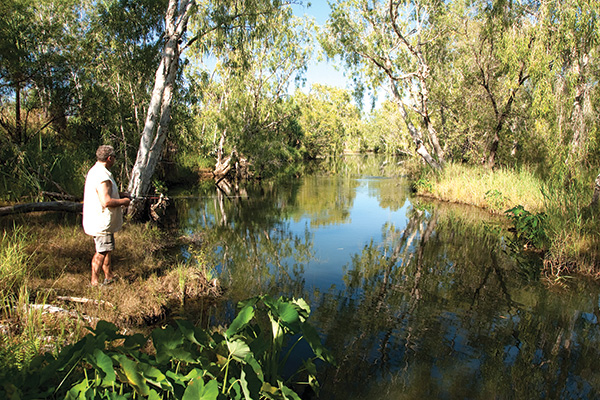


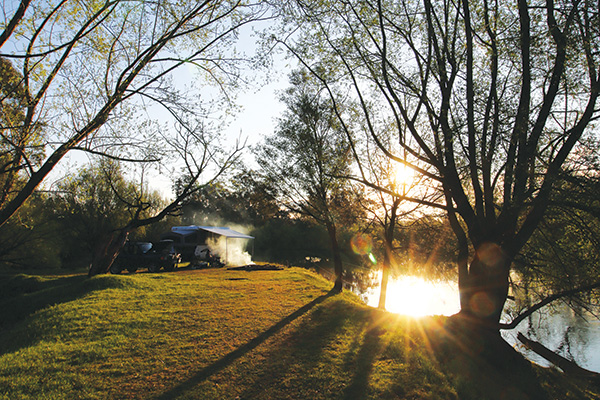
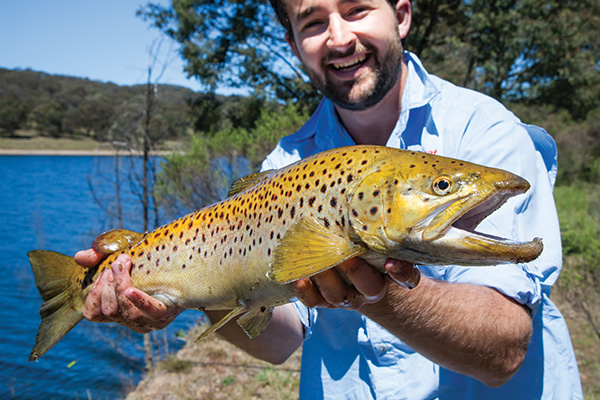
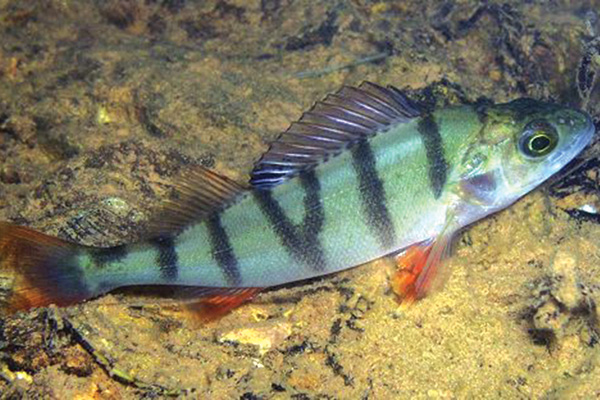
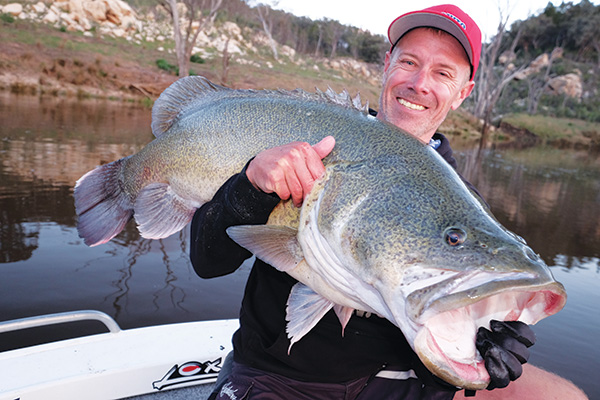
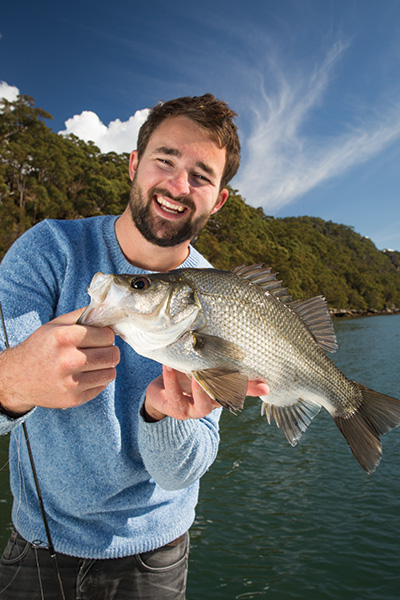

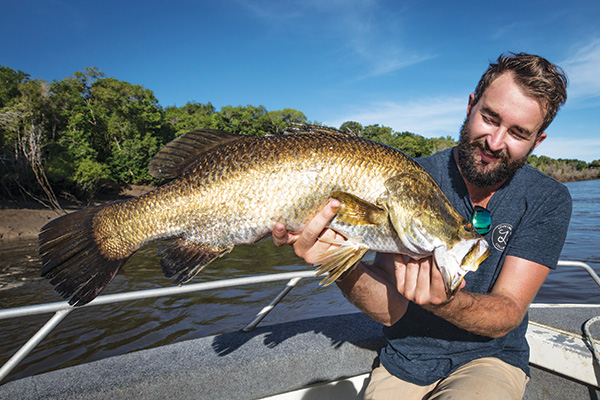
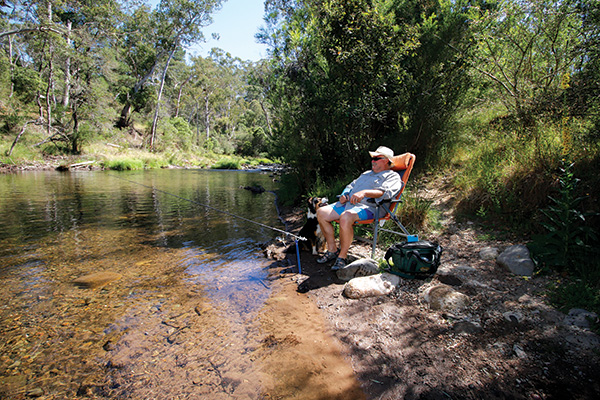
In this guide, we look at seven frequently targeted freshwater species but there are so many more, including Macquarie perch, silver perch, chinook salmon, trout cod, catfish, archerfish, eel, mangrove jack, river blackfish, mud crabs, saratoga and tench. This huge country presents such a wide variety of fresh and saltwater angling opportunities that it’s difficult to tick every species on the bucket list species in one lifetime - but not from a lack of trying!
So what are you waiting for? Chuck the rods and lures into the camper trailer and make a bee line for the closest body of water. Even if you catch bugger all you'll feel zen as hell for the experience, I promise.
TROUT
Alternative Names: Salmo trutta, spotted river foxes
Identification: Trout colouration varies with age and habitat, but they are often silvery or olive, with dark spots on the sides of the body. The spots are often surrounded by a lighter halo. Brown trout can have slight rainbow colouring, but no teeth or tongue, and no spots on their tail.
Size Range: Overseas trout may grow up to 1.4m (20kg), although in Australia, only our largest specimens may occasionally reach 90cm (14kg).
Distribution: Trout are an introduced species found in the cool streams, lakes and reservoirs of south-eastern Australia, Tasmania and south-western WA. Trout fishing is highly regulated and our dams and rivers are regularly stocked.
Habitat: Trout inhabit cool streams, lakes and reservoirs. They live in freshwater, but some run to the ocean and return to freshwater to spawn, just like salmon (which trout are closely related to).
Feeding and Diet: Trout eat small fish, insects, molluscs and crustaceans. It is a predator of small native species such as galaxids
Angling Methods: Fly Fishing is probably the most recognisable method of trout fishing. Mostly done in streams and rivers where trout swim in the shallow and attack at the surface. In lakes, dams and rivers, you can cast lures as you would in saltwater. Just add it to your balanced spinning rig and start chucking. Soft plastics, spinners, hard bodies are often combined with attractors like “Ford Fenders”. If I were to select my favorite, it would be a pink Tassie Devil.
Bait Fishing: Unweighted baits, running sinker rigs or float fishing with baits including mudeyes (dragonfly larvae), worms, yabbies, maggots, grubs, shell baits, cockroaches, crickets, grasshoppers, glassies and live baitfish.
Trolling and Jigging: Trolling delivers great results. Keep in mind that in certain areas, trout can stay very deep, so a downrigger may be essential for deeper lakes and dams.
Eating Quality: Trout are not only popular with anglers, they are also popular on the dinner table. However, taste can vary considerably according to their current eating habits and water quality. But they always taste great smoked!
REDFIN
Alternative Names: Perca fluviatilis, redfin perch, English perch, European Perch, reddy.
Identification: Redfin are easily recognised by black or red bands on the sides of their bodies. They have a quite distinct dark patch at the rear of the dorsal fin and well-defined red fins. Typically for most perch species, there’s a hump behind the depressed head and a fairly large mouth.
Size Range: While it’s been suggested that redfin can grow as large as 60cm and around 10kg, evidence is hard to find. The majority of fish encountered in Australian waters range from 300gm to about 2.5kg.
Distribution: Redfin are an introduced species that are common in freshwater environments in New South Wales, Victoria, south-eastern South Australia, Tasmania and south-western WA.
Habitat: Redfin prefer the sweetwater life in lakes, dams and slow flowing streams. Unlike many freshwater species that commonly enter saline estuaries, redfin prefer to stay sheltered amongst structure such as rocky outcrops and submerged trees.
Feeding and Diet: Crustaceans such as yabbies and shrimp, worms, molluscs, insect larvae and smaller fishes.
Angling Method: Redfin are one of the most popular freshwater fish in the country. Reddies are very easy to fish for with simple bait methods such as running sinker and paternoster rigs. They also engulf many lures types, particularly loving any presentation with similar colouring to themselves. You can spin, jig or troll and they’ll even take a fly. Redfin respond well to flashing attractors, livebaits of small fish, yabbies or shrimp and are suckers for a scrubworm.
MURRAY COD
Alternative Names: Goodoo, cod, greenfish, Mary River cod, Murray perch, ponde, pondi and Queensland freshwater cod.
Identification: The Murray cod is a large grouper-like fish with a deep, elongated body. It has a broad, scooped head, and a large mouth lined with pads of very small, needle-like teeth and the lower jaw protrudes slightly. Murray cod are white to cream on their belly with yellowish-green to green backs overlain with heavy darker green, but occasionally brown or black, mottling.
Size Range: The Murray cod is the largest freshwater fish in Australia, and one of the largest in the world. Adult Murray cod regularly reach 80-100cm. They are capable of growing to more than 1m and the largest on record was above 1.8 m and about 113kg (249lb) in weight.
Distribution: The Murray cod is named after the Murray River and their natural range encompasses the whole Murray-Darling basin, particularly the lowland areas, and extending well into upland areas. They extend from southern Queensland, through New South Wales, the Australian Capital Territory and Victoria to South Australia.
Habitat: Murray cod inhabit a remarkably wide variety of habitats, from cool, clear, fast-flowing streams in upland areas to large, slow flowing, meandering rivers in the extensive alluvial lowland reaches of the Murray-Darling basin.
Feeding and Diet: A long-lived fish, adult Murray cod are carnivorous and mainly eat other fish. The Murray cod is the apex aquatic predator in Aussie freshwater and will eat almost anything smaller than itself including smaller Murray cod, golden perch, silver perch, bony bream, eel-tailed catfish, and introduced fish such as carp, goldfish, and redfin, plus yabbies, freshwater shrimp, and Murray crayfish. Murray cod have even been known to eat ducks, cormorants, freshwater turtles, water dragons, snakes, mice, and frogs.
Angling Method: Murray cod can be caught on bait or lure, but targeting them on lure is far more exciting and enables you to cover more ground in your pursuit. Keep on the move, casting big lures into likely structure. The warmer months are better – you still get fish in winter, but they become less active around April onwards. Murray cod will bite throughout the day, however early morning and evening still remain prime times. Best lures include large deep-diving, hard body minnows, large spinnerbaits, double blade spinnerbaits, lipless crankbaits, soft plastics, jitterbugs and other surface lures.
Best Bait: Live yabbies, bardi grubs. Many also swear by cheese, fish fingers and other strange baits that attract local shrimp.
Eating Quality: Many love them, but just as many dislike them. A large, flaky flesh that needs all of the fat removed or it spoils the taste.
AUSTRALIAN BASS
Alternative Names: Macquaria novemaculeata, perch
Identification: Australian bass are closely related and very similar in appearance to estuary perch, yet are a predominantly freshwater species. They have a thick slightly forked tail with a concave head profile and a spiky dorsal fin attached to a softer second dorsal fin on their backs. They have a large mouth with a protruding lower jaw. Their spines and gills are very sharp so take care in handling.
Size Range: Maximum recorded age is 22 years and males are smaller than females up to around (usually around 1kg) while females sometimes reach the maximum size of 2.5-3kg.
Distribution: Australian bass are found in rivers, streams, coastal lakes and brackish estuaries. They love to hide out in structure and thick vegetation with rock and gravel-bottom. They require estuarine waters to reproduce, but are stocked in many impoundments in south-eastern Australia.
Habitat: Australian bass are primarily a freshwater riverine species, but they do require the natural salinity of an estuary to breed. They will generally reside upstream in the freshwater for the warmer seasons and move down to the saline influence during the cooler months. Aussie bass are fast and ferocious predators when prey happens by. They can be found in water as shallows as 1m, or can also be found in the deeper rock pools and drop offs, too. Aussie bass regularly hunt at night in shallow water and will often strike at surface lures and other prey.
Feeding and Diet: Australian bass feed on a myriad of insects with a real taste for larger species such as cicadas. They will feed on worms, crabs, shrimp, spiders, molluscs and a variety of invertebrates as well as small fish, shrimp and prawns.
Angling Methods: Australian bass are very popular and powerful sportsfish. They are very fast and strong and dirty fighters when hooked, heading straight for the safety of snags and shelter, so they need to be pulled up fast and turned after hook-up. Surface strikes can be explosive! Bass will strike a wide range of well-presented lures and flies cast around structure. These range from surface lures, blades, bibbed divers, spinnerbaits, poppers, flies and soft plastics.
Eating Quality: Australian bass fishermen almost exclusively practice catch and release to preserve stocks.
YELLOWBELLY
Alternative Names: Golden perch, goldens or callop.
Identification: Golden perch are medium-sized fish, commonly around 30-40cm and 1-2kg in rivers. Bred fish tend to be much deeper-bodied and show greater average and maximum sizes reaching up to 15kg vs 9kg in a stream. They have a deep, but laterally compressed body, with a sizable mouth, small to moderate-sized eyes, a curved forehead, and a hump above the head. Beware of the spine on the gills! Golden perch vary in colour from pale silvery-gold in clear waters to deep yellow/gold or bronze in tannin waters.
Size Range: Common length 40cm, maximum length 75cm.
Distribution: Prefers warm, slow moving streams, but also found in flooded backwaters and stocked impoundments. Golden perch are native primarily to lowland reaches of the Murray-Darling River system, but also extend far into lower upland reaches. They are found in similar territory as Murray cod and can be caught with the same methods.
Habitat: The yellowbelly prefers the warm inland waters, backwaters and billabongs that are spread throughout the Murray-Darling basin. Wild yellowbellies tend to be leaner in shape and more intensely golden in colour, and some say better eating.
Feeding and diet: Adult golden perch are carnivores, feeding on smaller fish and crustaceans, including yabbies, shrimp, frogs, small fish, and aquatic invertebrates
Angling Method: Yellowbelly are suckers for livebaits like yabbies and scrub worms, usually fished with simple running sinker rigs. They love hard bodies bibbed lures, spinnerbaits and even soft plastics. Look for them amongst the snags and other structure.
Note: Yellowbelly have sharp plates on their gills so take care when handling.
BARRAMUNDI
Alternative Names: Barra, Lates calcarifer, Asian sea bass
Identification: While barramundi might be regarded as an iconic fish in Australia, they are also found in other areas such as Papua New Guinea and South East Asia. Barramundi have an elongated body, a concave forehead and a large jaw extending behind the eye. Barramundi range from pure silver to bronze, or blue to green-grey, dependent on their environment and can be found in both salt and fresh water. They are said to reach up to 1.8m, yet metre-long fish are considered exceptional captures. Barramundi will inhabit coastal waters, estuaries, lagoons, and rivers, but are also stocked as sportsfish into freshwater impoundments preferring warm waters around 24-30ºC.
Size Range: The maximum weight is about 60kg and the average length is about 0.6-1.2m.
Distribution: This species is widely distributed in the Indo-West Pacific region from Southeast Asia to Papua New Guinea and Northern Australia. They are naturally occurring in waters north of the Exmouth Gulf in WA, across the top end to Hervey Bay and the Mary and Maroochy rivers in Southern Queensland.
Habitat: Barramundi generally inhabit rivers, estuaries and tidal flats where they move down the systems to spawn and yet purely marine populations also occur where freshwater flow is scarce. At the start of the monsoon, males migrate downriver to meet females, which lay very large numbers of eggs that require brackish water to develop. Barramundi are hermaphroditic, with most individuals maturing as males and becoming female after at least one spawning season; hence most of the larger specimens are therefore female. Barramundi can live in purely fresh water, but will not breed and make an ideal species for impoundment stocking.
Feeding and Diet: Barramundi feed on crustaceans, molluscs, and smaller fish.
Angling Method: Barramundi are highly prized by anglers for their fighting ability. In Australia, the barramundi is used to stock freshwater reservoirs for recreational fishing. Barra can be caught with both lures and livebaiting with mullet, herring, cherabin and prawns being almost impossible to refuse. Barra will strike a full array of lures, surface swimmers, poppers, bibbed lures, stick baits, spinnerbaits and soft plastics will all entice action with the old faithful “Gold Bomber” being a traditional favourite. Lures can be thrown, particularly around structure such as rock bars, mangroves, sunken trees and drop offs or trolled. Popular stocked barramundi impoundments include Lake Tinaroo near Cairns in the Atherton Tablelands, Peter Faust Dam near the Whitsundays, Teemburra Dam near Mackay, Lake Moondarra near Mount Isa, Lake Awoonga near Gladstone, and Lake Monduran south of Lake Awoonga.
EATING QUALITY: Excellent
YABBY, MARRON AND FRESHWATER CRAYFISH
Alternative Names: Blue claw, crayfish, spiny crayfish, Murray crayfish.
Identification: Yabbies have four pairs of legs, a strong paddle tail, tough claws, three sets of antennae and very strong shells. They mostly walk along the bottom or dig holes, but can swim very fast by flapping their tails. Spiny crayfish are similar, but bigger and have a thick armour coating of sharp spines. Most yabbies are brown to dark green in colour, while spiny crayfish will vary from almost black to lighter accents, with tinges of red, orange and even silver.
Size Range: Yabbies usually grow up to 150mm, but can reach 200mm in ideal environments. Spiny and Murray crayfish may grow to more than 300mm weigh up to 2kg. Some very rare monster-sized crayfish are also found in the forest streams of Tasmania.
Distribution: Yabbies are found Australia-wide and prefer slow flowing waterways, dams and impoundments. They will survive drought and cold water by burying deep, virtually hibernating. Freshwater crayfish prefer flowing water and are more concentrated in the southern eastern highlands and tributaries. Marron belong to WA, with a few found in New South Wales and Victoria.
Habitat: These delicious critters live in dams, waterholes, creeks, irrigation channels and most inland still waters. They house themselves in small tunnels that they dig into the sides of streams and dams, often under the shelter of rocks, logs and other structure.
Feeding and diet: Yabbies eat algae, dead and decaying plants, plus fish and other decaying animals.
Angling Method: Yabbies and crayfish can both be caught in hoop nets and pots, but please check local regulations as they vary greatly from state to state. Pots are baited with live bloody meat. Liver is great, but can be soft to tie into the pot; any off meat leaching blood is fine. You can even just tie it to the end of a string. When they strike,slowly walk it to the bank and net from behind.
Eating quality: Boil yabbies in a pot for three minutes (depending on size) with salt, vinegar and a selection of herbs till they turn red.




